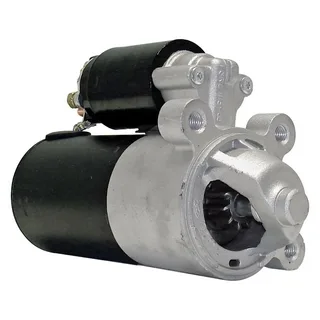The Ford Escape v6 starter motor is essential for initiating the engine’s operation. It converts electrical energy from the battery into mechanical energy, enabling the engine to start. The starter motor is located near the transmission and is vital to the vehicle’s starting system. Understanding how this part functions can significantly aid in diagnosing issues and performing replacements. Proper knowledge of the starter motor’s role and location is crucial for maintaining the vehicle’s reliability and performance.
Indications of a Malfunctioning Starter Motor
A malfunctioning starter motor in a Ford Escape V6 can display several distinct signs. One of the primary indicators is a clicking noise when turning the ignition key, suggesting the motor is struggling to engage. Another common symptom is the engine’s failure to start despite the battery being in good condition.
Additionally, experiencing intermittent starting issues, where the vehicle begins only occasionally, can also point to a faulty starter motor. If the dashboard lights illuminate but the engine remains silent, it could indicate a problem with the starter motor. Addressing these symptoms promptly can help avoid further complications and maintain the vehicle’s reliability.
Essential Tools for Diagnosis and Replacement
Diagnosing and replacing the starter motor in a Ford Escape V6 necessitates a specific array of tools.
Socket Set
Among these, a socket set and spanners are crucial for removing and securing various components.
Screwdriver Set
A screwdriver set is essential for loosening and tightening screws during the process.
Multi Meter
A multi meter is indispensable for checking the battery and electrical connections for electrical testing.
A Creeper
Additional tools, such as a creeper, can provide comfortable access underneath the vehicle, while a torch ensures clear visibility in dimly lit areas.
Accurate Diagnosis
These tools collectively facilitate an efficient and accurate diagnosis and replacement of the starter motor.
Identifying Starter Motor Issues
Identifying starter motor issues in a Ford Escape V6 requires a systematic approach. Begin by checking the battery and connections for any loose or corroded terminals. Using a multi meter, verify the voltage level of the battery to ensure it is adequately charged. Listen for any unusual sounds when starting the engine, which can indicate starter motor problems.
Inspecting related components, such as the starter relay and solenoid, is crucial for a comprehensive diagnosis. Detecting a faulty starter motor early on can prevent more extensive repairs and ensure the vehicle remains dependable.
Preparations for Starter Motor Replacement
Before beginning the starter motor replacement, it is crucial to take several preparatory steps. First, ensure the vehicle is on a stable surface to prevent movement. The ignition must be turned off and the key removed to avoid accidental starts. Disconnecting the battery is essential to eliminate any electrical risks during the process.
Clear the working area by removing the engine cover or any nearby components that could obstruct access to the starter motor. Gathering all necessary tools in advance, such as socket sets, spanners, and a multi meter, will streamline the replacement procedure.
Extracting the Defective Starter Motor
First, to remove the faulty starter motor from a Ford Escape V6, locate it beneath the vehicle near the gearbox.
- Carefully disconnect the wiring connected to the starter motor, ensuring all connections are clearly labelled for easy reassembly.
- Proceed to remove the mounting bolts securing the starter motor in place.
- Gently detach the motor from its housing, avoiding damaging surrounding components.
- Utilizing the appropriate tools, such as socket sets and spanners, ensures the process is efficient and safe.
- Once the defective motor is free, it can be set aside, making space for the new starter motor.
Fitting the Replacement Ford Escape Starter Motor
Begin the installation of the new Ford Escape Starter Motor by aligning it with the mounting holes in its designated location. Secure the motor with the appropriate bolts, ensuring each is tightened to the manufacturer’s specified torque settings to maintain stability. Reconnect the wiring harness, paying close attention to the labels to ensure accurate connections.
Verify that all electrical connections are secure to avoid potential issues with the starter motor’s operation. It’s essential to handle each component with care to prevent damage during the installation process. Proper alignment and secure connections will ensure the starter motor functions optimally.
Checks Following Installation
After installing the new starter motor in the Ford Escape V6, conducting several checks is imperative to ensure proper functionality.
Ignition
Begin by turning the ignition to verify that the engine starts without hesitation.
Unusual Sounds
Any unusual sounds during this process could signify improper alignment or loose components.
Electrical Connections
It is essential to inspect all electrical connections, ensuring they are tight and secure, as loose connections can lead to starting problems.
Signs of Leaks
The surrounding area should also be examined for any signs of leaks or displaced parts that might have been inadvertently disturbed during the installation.
Signs of Leaks
These checks confirm that the new starter motor is correctly installed and operating efficiently.
Prolonging Starter Motor Longevity
Proper maintenance and mindful usage can significantly extend the life of a starter motor in a Ford Escape V6. Regularly checking the battery and its connections is crucial to ensure consistent electrical flow, as a reliable power source prevents undue strain on the starter motor.
Cleaning the terminals to remove any buildup of corrosion can also enhance electrical conductivity. Avoiding frequent short trips can be beneficial, as they require the starter motor to engage more often, accelerating wear. Ensuring that the vehicle’s electrical system is well-maintained and functioning optimally reduces the likelihood of electrical issues impacting the starter motor.
Additionally, periodically inspecting the starter motor and its surrounding components for wear and tear can help identify potential problems before they escalate. Taking these preventive measures not only helps prolong the starter motor’s operational life but also contributes to the overall reliability of the Ford Escape V6.
Mistakes to Steer Clear Of
Neglecting to disconnect the battery before starting work is a standard error that can lead to electrical hazards. Overlooking corroded or loose connections may cause persistent starting issues even after replacing the starter motor. Following the manufacturer’s torque specifications when securing the new starter motor is crucial. Failure to do so can result in improper alignment and potential damage to surrounding components.
Another mistake is not labelling the wiring during disconnection, which can complicate reassembly and lead to incorrect connections. Using inappropriate tools or applying excessive force can damage the starter motor and other vehicle parts. Being meticulous during the replacement process is essential to avoid these pitfalls and ensure a smooth and successful installation.
When to Seek Professional Help
Recognising the appropriate moment to seek professional help can be crucial in avoiding further issues. If the Ford Escape V6 continues to exhibit starting problems even after replacing the starter motor, it may indicate a more complex underlying issue.
Electrical diagnostics can often be intricate, and a qualified mechanic possesses the specialized equipment and expertise to identify and address the problem accurately. Additionally, if the initial diagnosis of the starter motor is proving particularly challenging, enlisting the assistance of a professional can ensure a more precise and efficient resolution.
Complexities such as faulty wiring, malfunctioning ignition switch, or vehicle computer system issues may require professional intervention. When choosing a mechanic, it is beneficial to consider their experience with Ford vehicles and their reputation within the automotive community.
Conclusion
In concluding the examination of the Ford Escape v6 starter motor, it is evident that understanding its function and identifying signs of failure is paramount. Utilizing the correct tools facilitates diagnosis and replacement, while a methodical approach ensures precision and efficiency. Regular maintenance practices can significantly enhance the longevity of the starter motor, reducing the frequency of replacements. Avoiding common errors, such as neglecting to disconnect the battery or improperly securing the motor, is crucial to prevent further complications. Recognizing when to seek professional assistance is vital, particularly when facing persistent issues or complex diagnostics.
FAQs
What are the common signs that indicate the starter motor in a Ford Escape V6 needs to be replaced?
Common signs include a clicking noise when you turn the key, the engine cranking slowly or not at all, intermittent starting issues, and visible damage or corrosion on the starter motor. If you notice any of these symptoms, inspecting and potentially replacing the starter motor is likely time.
How can I diagnose a faulty Ford Escape v6 starter motor?
To diagnose a faulty Ford Escape v6 starter motor, check the battery and its connections to ensure they are in good condition. If the battery is fine, listen for any clicking noises when attempting to start the vehicle. You can also test the starter motor using a multi meter to check for proper voltage and current. If the starter motor fails these tests, it may need to be replaced.
What steps are involved in replacing the starter motor in a Ford Escape V6?
To replace the starter motor:
- Disconnect the battery to ensure safety.
- Locate the starter motor, typically found near the bottom of the engine.
- Remove any components obstructing access to the starter motor, such as the engine cover or skid plate.
- Disconnect the electrical connections and mounting bolts securing the starter motor.
- Remove the old starter motor and install the new one by reversing the removal steps.
| Related Business Listings |
| Contact Directory |
| Local Business Profiles |


